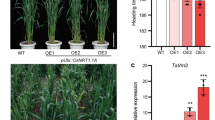Abstract
Three types of transgenic tobacco plants were acquired by separate transformation or co-transformation of a vacuolar Na+/H+ antiporter gene, SeNHX1, and a betaine synthesis gene, BADH. When exposed to 200 mM NaCl, the dual gene-transformed plants displayed greater accumulation of betaine and Na+ than their wild-type counterparts. Photosynthetic rate and photosystem II activity in the transgenic plants were less affected by salt stress than wild-type plants. Transgenic plants exhibited a greater increase in osmotic pressure than wild-type plants when exposed to NaCl. More importantly, the dual gene transformed plants accumulated higher biomass than either of the single transgenic plants under salt stress. Taken together, these findings indicate that simultaneous transformation of BADH and SeNHX1 genes into tobacco plants can enable plants to accumulate betaine and Na+, thus conferring them more tolerance to salinity than either of the single gene transformed plants or wild-type tobacco plants.




Similar content being viewed by others
References
Apse MP, Sottosanto JB, Blumwald E (2003) Vacuolar cation/H+ exchange, ion homeostasis, and leaf development are altered in a T-DNA insertional mutant of AtNHX1, the Arabidopsis vacuolar Na+/H+ antiporter. Plant J 36:229–239
Bohnert HJ, Golldack D, Ishitani M, Kamasani UR, Rammesmayer G, Shen B, Sheleva E, Jensen KJ (1996) Salt tolerance engineering requires multiple gene transfer. In: Collins GB, Shepherd RJ (ed) Engineering plants for commercial products and application. Ann NY Acad Sci 729:115–125
Brini F, Hanin M, Mezghani I, Berkowitz GA, Masmoudi K (2007) Overexpression of wheat Na+/H+ antiporter TNHX1 and H+-pyrophosphatase TVP1 improve salt- and drought-stress tolerance in Arabidopsis thaliana plants. J Exp Bot 58:301–308
Chen THH, Murata N (2002) Enhancement of tolerance of abiotic stress by metabolic engineering of betaines and other compatible solutes. Curr Opin Plant Biol 5:250–257
Chen SL, Bi WF, Li JK, Wang SS (2000) Quantitative determination of glycinebetaine in plant tissues by reverse phase ion-pare HPLC. Acta Bot Sin 42:1014–1018 (in Chinese, with English abstract)
Chen H, An R, Tang JH, Cui XH, Hao FS, Jia C, Wang XC (2007) Over-expression of a vacuolar Na+/H+ antiporter gene improves salt tolerance in an upland rice. Mol Breed 19:215–225
Flowers TJ, Troke PF, Yeo AR (1977) The mechanism of salt tolerance in halophytes. Annu Rev Plant Physiol 28:89–121
Hitz WD, Hanson AD (1980) Determination of glycine betaine by pyrolysis-gas chromatography in cereals and grasses. Phytochemistry 19:2371–2374
Holmström KO, Somersalo S, Mandal A, Palva TE, Welin B (2000) Improved tolerance to salinity and low temperature in transgenic tobacco producing glycine betaine. J Exp Bot 51:177–185
Nuccio ML, Russell BL, Nolte KD, Rathinasabapathi B, Gage DA, Hanson AD (1998) The endogenous choline supply limits glycine betaine synthesis in transgenic tobacco expressing choline monooxygenase. Plant J 16:487–496
Ohnishi N, Murata N (2006) Glycinebetaine counteracts the inhibitory effects of salt stress on the degradation and synthesis of D1 protein during photoinhibition in Synechococcus sp. PCC 7942. Plant Physiol 141:758–765
Park EJ, Jeknić Z, Sakamoto A, DeNoma J, Yuwansiri R, Murata N, Chen THH (2004) Genetic engineering of glycinebetaine synthesis in tomato protects seeds, plants, and flowers from chilling damage. Plant J 40:474–487
Quan RD, Shang M, Zhang H, Zhao YX, Zhang JR (2004) Engineering of enhanced glycine betaine synthesis improves drought tolerance in maize. Plant Biotechnol J 2:477–486
Sakamoto A, Murata N (2001) The use of bacterial choline oxidase, a glycinebetaine-synthesizing enzyme, to create stress-resistant transgenic plants. Plant Physiol 125:180–188
Sambrook J, Fritsch EF, Maniatis T (1989) Molecular cloning: a laboratory manual, 2nd edn. Cold Spring Harbor Press, Cold Spring Harbor
Saneoka H, Nagasaka C, Hahn DT, Yang WJ, Premachandra GS, Joly RJ, Rhodes D (1995) Salt tolerance of glycinebetaine-deficient and-containing maize lines. Plant Physiol 107:631–638
Su J, Hirji R, Zhang L, He C, Selvaraj G, Wu R (2006) Evaluation of the stress-inducible production of choline oxidase in transgenic rice as a strategy for producing the stress-protectant glycine betaine. J Exp Bot 57:1129–1135
Volkov V, Amtmann A (2006) Thellungiella halophila, a salt-tolerant relative of Arabidopsis thaliana, has specific root ion-channel features supporting K+/Na+ homeostasis under salinity stress. Plant J 48:342–353
Wang B, Davenport RJ, Volkov V, Amtmann A (2006) Low unidirectional sodium influx into root cells restricts net sodium accumulation in Thellungiella halophila, a salt-tolerant relative of Arabidopsis thaliana. J Exp Bot 57:1161–1170
Weretilnyk EA, Hanson AD (1990) Molecular cloning of a plant betaine-aldehyde dehydrogenase, an enzyme implicated in adaptation to salinity and drought. Proc Natl Acad Sci USA 87:2745–2749
Yang XH, Lu CM (2005) Photosynthesis is improved by exogenous glycinebetaine in salt-stressed maize plants. Physiol Plant 124:343–352
Zhang HX, Hodson JN, Williams JP, Blumwald E (2001) Engineering salt-tolerant Brassica plants: Characterization of yield and seed oil quality in transgenic plants with increased vacuolar sodium accumulation. Proc Natl Acad Sci USA 98:12832–12836
Zhu JK (2003) Regulation of ion homeostasis under salt stress. Curr Opin Plant Biol 6:441–445
Acknowledgements
We thank Prof. Shouyi Chen, Institute of Genetics and Developmental Biology, Chinese academy of sciences, for providing the plasmid pBin438. We particularly thank Dr. Wenhao Zhang for major revision of this manuscript. This work was financially supported by the National High Technology and Research Development Program of P. R. China (“863” project) (Grant No. 2007AA091705) and the Key Directional Research Project of CAS (Grant No. KSCX2-YW-N-003 and 013).
Author information
Authors and Affiliations
Corresponding author
Electronic supplementary material
Rights and permissions
About this article
Cite this article
Zhou, S., Chen, X., Zhang, X. et al. Improved salt tolerance in tobacco plants by co-transformation of a betaine synthesis gene BADH and a vacuolar Na+/H+ antiporter gene SeNHX1 . Biotechnol Lett 30, 369–376 (2008). https://doi.org/10.1007/s10529-007-9548-6
Received:
Revised:
Accepted:
Published:
Issue Date:
DOI: https://doi.org/10.1007/s10529-007-9548-6




